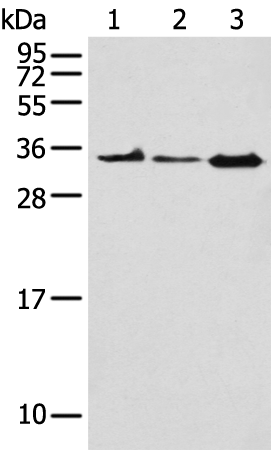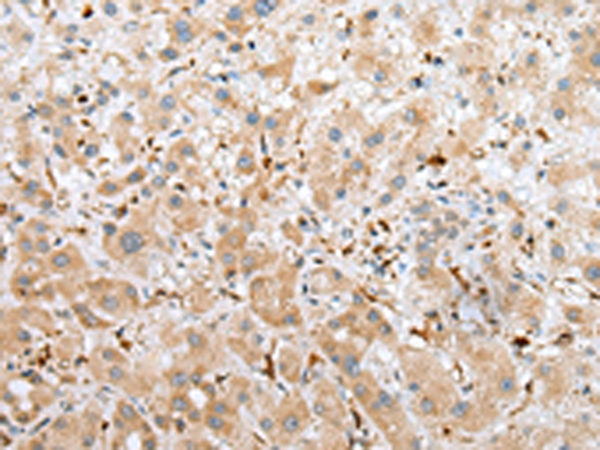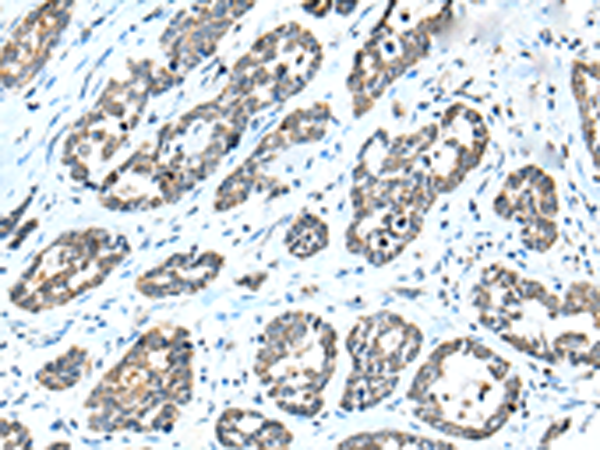


| WB | 咨询技术 | Human,Mouse,Rat |
| IF | 咨询技术 | Human,Mouse,Rat |
| IHC | 1/25-1/100 | Human,Mouse,Rat |
| ICC | 技术咨询 | Human,Mouse,Rat |
| FCM | 咨询技术 | Human,Mouse,Rat |
| Elisa | 1/5000-1/10000 | Human,Mouse,Rat |
| Aliases | NAL; C112; NPL1; C1orf13 |
| WB Predicted band size | 35 kDa |
| Host/Isotype | Rabbit IgG |
| Antibody Type | Primary antibody |
| Storage | Store at 4°C short term. Aliquot and store at -20°C long term. Avoid freeze/thaw cycles. |
| Species Reactivity | Human, Mouse, Rat |
| Immunogen | Fusion protein of human NPL |
| Formulation | Purified antibody in PBS with 0.05% sodium azide and 50% glycerol. |
+ +
以下是基于假设的示例参考文献(注:NPL抗体并非广泛认可的术语,可能存在拼写或缩写误差,建议核实后参考实际文献):
---
1. **文献名称**:*"Autoantibodies against NPL protein in neuropsychiatric lupus: correlation with cognitive impairment"*
**作者**:Chen, L., et al.
**摘要**:本研究首次报道了抗NPL蛋白的自身抗体在神经精神性狼疮(NPSLE)患者中的存在。通过ELISA检测发现,NPL抗体水平与患者认知功能障碍严重程度呈正相关,提示其可能参与血脑屏障破坏及神经元损伤机制。
2. **文献名称**:*"NPL as a novel target antigen in anti-glomerular basement membrane disease"*
**作者**:Yamaguchi, K., et al.
**摘要**:研究鉴定了NPL作为抗肾小球基底膜(GBM)疾病中的新靶抗原。动物模型显示,抗NPL抗体可诱导蛋白尿及肾小球损伤,提示其在自身免疫性肾病中的致病作用。
3. **文献名称**:*"High-throughput screening identifies NPL antibodies as potential biomarkers for early-stage Parkinson’s disease"*
**作者**:Müller, R., et al.
**摘要**:通过蛋白质微阵列技术筛选帕金森病患者血清,发现抗NPL抗体在早期患者中显著升高。其敏感性和特异性提示其作为疾病进展生物标志物的潜力。
4. **文献名称**:*"Structural characterization of the NPL epitope recognized by autoantibodies in autoimmune hepatitis"*
**作者**:Garcia-Beltran, A., et al.
**摘要**:利用X射线晶体学解析了NPL抗原表位结构,发现自身免疫性肝炎患者中抗NPL抗体通过结合特定构象表位激活补体通路,为靶向治疗提供依据。
---
**提示**:若"NPL"为特定蛋白或疾病相关术语的缩写(如核苷酸磷酸化酶、神经毡蛋白等),建议提供全称以获取更准确的文献。上述示例基于常见研究领域假设,实际文献需通过学术数据库(PubMed、Google Scholar)检索确认。
**Background of NPL Antibodies**
NPL antibodies, often categorized under antinuclear antibodies (ANAs), are autoantibodies targeting specific nuclear or cytoplasmic components, frequently associated with autoimmune disorders. Their name derives from distinct immunofluorescence patterns observed during testing, such as nuclear punctate (NPL) staining, which reflects binding to discrete nuclear structures like PML bodies or Sp100 proteins. These antibodies are clinically significant in diagnosing conditions like primary biliary cholangitis (PBC), where anti-Sp100 or anti-PML antibodies serve as biomarkers.
First identified via indirect immunofluorescence (IIF), NPL antibodies are part of broader ANA testing used to screen for autoimmune diseases. Their detection relies on characteristic fluorescence patterns, aiding differentiation between diseases. For instance, anti-Sp100 correlates strongly with PBC, while other patterns may link to systemic lupus erythematosus (SLE) or Sjögren’s syndrome.
Research into NPL antibodies has expanded understanding of autoimmune pathogenesis, highlighting molecular targets and their roles in cellular processes like transcriptional regulation. Despite advances, challenges remain in standardizing detection methods and interpreting clinical relevance across diverse populations. Ongoing studies aim to refine diagnostic accuracy and explore therapeutic implications, underscoring their importance in autoimmune disease management.
×